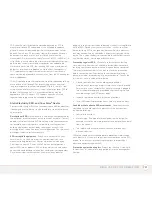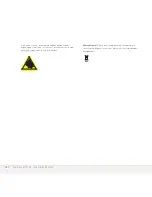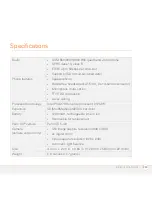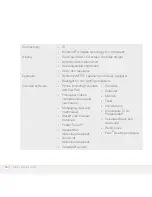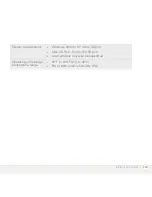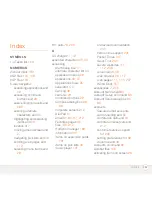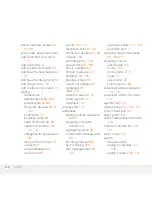
R E G U L A T O R Y I N F O R M A T I O N
253
The energy levels associated with radiofrequency energy, including
both radio waves and microwaves, are not great enough to cause the
ionization of atoms and molecules. Therefore, RF energy is a type of
non-ionizing radiation. Other types of non-ionizing radiation include
visible light, infrared radiation (heat) and other forms of
electromagnetic radiation with relatively low frequencies.
Large amounts of RF energy can heat tissue. This can damage
tissues and increase body temperatures. Two areas of the body, the
eyes and the testes, are particularly vulnerable to RF heating because
there is relatively little blood flow in them to carry away excess heat.
The amount of RF radiation routinely encountered by the general
public is too low to produce significant heating or increased body
temperature. Still, some people have questions about the possible
health effects of low levels of RF energy. It is generally agreed that
further research is needed to determine what effects actually occur
and whether they are dangerous to people. In the meantime,
standards-setting organizations and government agencies are
continuing to monitor the latest scientific findings to determine
whether changes in safety limits are needed to protect human health.
FDA, EPA and other US government agencies responsible for public
health and safety have worked together and in connection with WHO
to monitor developments and identify research needs related to RF
biological effects.
What levels of RF energy are considered safe?
Various
organizations and countries have developed standards for exposure
to radiofrequency energy. These standards recommend safe levels of
exposure for both the general public and for workers. In the United
States, the FCC has used safety guidelines for RF environmental
exposure since 1985.
The FCC guidelines for human exposure to RF electromagnetic fields
are derived from the recommendations of two expert organizations,
the National Council on Radiation Protection and Measurements
(NCRP) and the Institute of Electrical and Electronics Engineers
(IEEE). In both cases, the recommendations were developed by
scientific and engineering experts drawn from industry, government,
and academia after extensive reviews of the scientific literature
related to the biological effects of RF energy.
Many countries in Europe and elsewhere use exposure guidelines
developed by the International Commission on Non-Ionizing Radiation
Protection (ICNIRP). The ICNIRP safety limits are generally similar to
those of the NCRP and IEEE, with a few exceptions. For example,
ICNIRP recommends different exposure levels in the lower and upper
frequency ranges and for localized exposure from certain products
such as hand-held wireless telephones. Currently, the World Health
Organization is working to provide a framework for international
harmonization of RF safety standards.
The NCRP, IEEE, and ICNIRP all have identified a whole-body Specific
Absorption Rate (SAR) value of 4 watts per kilogram (4 W/kg) as a
threshold level of exposure at which harmful biological effects may
occur. Exposure guidelines in terms of field strength, power density
and localized SAR were then derived from this threshold value. In
addition, the NCRP, IEEE, and ICNIRP guidelines vary depending on
the frequency of the RF exposure. This is due to the finding that
whole-body human absorption of RF energy varies with the
frequency of the RF signal. The most restrictive limits on whole-body
exposure are in the frequency range of 30-300 MHz where the
human body absorbs RF energy most efficiently. For products that
only expose part of the body, such as wireless phones, exposure
limits in terms of SAR only are specified.
The exposure limits used by the FCC are expressed in terms of SAR,
electric and magnetic field strength, and power density for
transmitters operating at frequencies from 300 kHz to 100 GHz. The
specific values can be found in two FCC bulletins, OET Bulletins 56
and 65: http://www.fcc.gov/oet/info/documents/bulletins/#56;
http://www.fcc.gov/oet/info/documents/bulletins/#65.
Why has the FCC adopted guidelines for RF exposure?
The FCC
authorizes and licenses products, transmitters, and facilities that
generate RF and microwave radiation. It has jurisdiction over all
transmitting services in the U.S. except those specifically operated by
the Federal Government. While the FCC does not have the expertise
to determine radiation exposure guidelines on its own, it does have
the expertise and authority to recognize and adopt technically sound
standards promulgated by other expert agencies and organizations,
and has done so. (Our joint efforts with the FDA in developing this
website is illustrative of the kind of inter-agency efforts and
consultation we engage in regarding this health and safety issue.)
Summary of Contents for TREO 680
Page 1: ...Your Palm Treo 680 Smart Device User Guide...
Page 10: ...W E L C O M E 4...
Page 32: ...In this chapter Moving around the screen 27 Using the keyboard 31 Opening applications 35...
Page 114: ...Y O U R E M A I L A N D O T H E R M E S S A G E S 108 4 C H A P T E R...
Page 134: ...In this chapter Camera 129 Pictures Videos 133 Pocket Tunes 139...
Page 152: ...Y O U R P H O T O S V I D E O S A N D M U S I C 146 6 C H A P T E R...
Page 154: ...In this chapter Calendar 149 World Clock 156 Tasks 158...
Page 168: ...Y O U R P E R S O N A L I N F O R M A T I O N O R G A N I Z E R 162 7 C H A P T E R...
Page 170: ...In this chapter Documents To Go Professional 165 Memos 166 Voice Memo 167...
Page 200: ...Y O U R A P P L I C A T I O N A N D I N F O M A N A G E M E N T T O O L S 194 9 C H A P T E R...
Page 220: ...Y O U R P E R S O N A L S E T T I N G S 214 10 C H A P T E R...
Page 250: ...C O M M O N Q U E S T I O N S 244 11 C H A P T E R...
Page 252: ...W H E R E T O L E A R N M O R E 246...
Page 272: ...S P E C I F I C A T I O N S 266...
Page 312: ...I N D E X 306...























